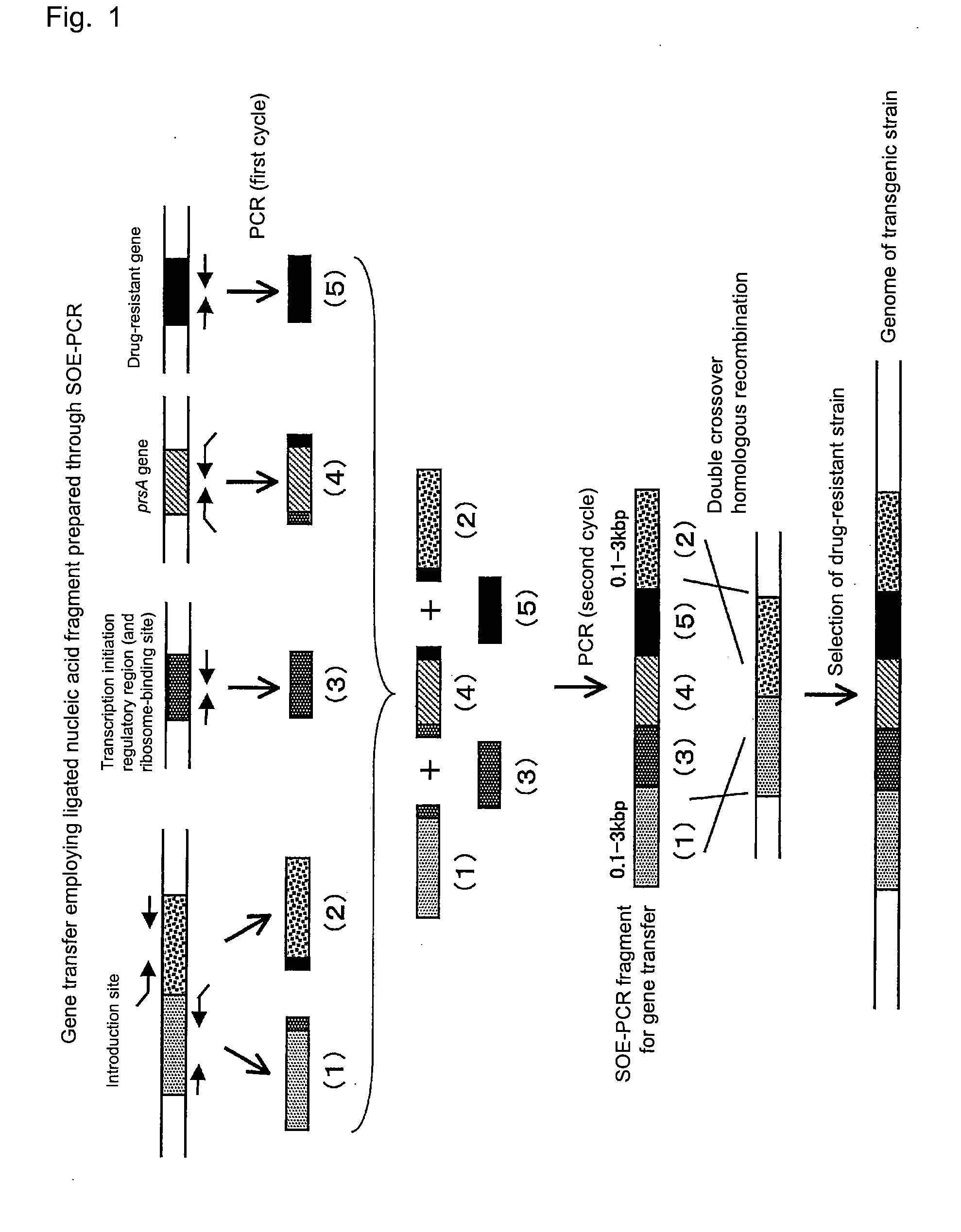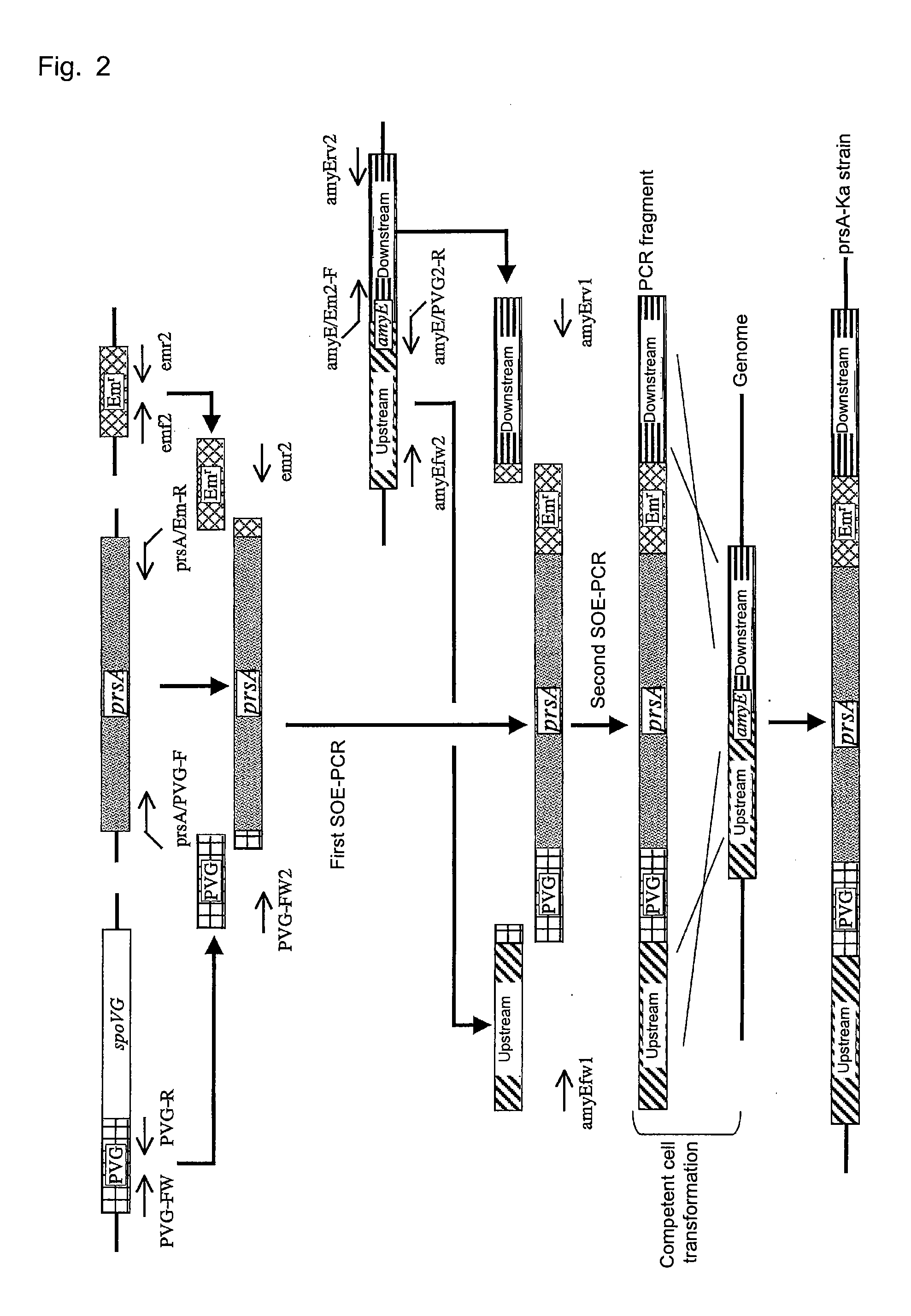Recombinant Microorganism
a technology of recombinant microorganisms and recombinant proteins, which is applied in the direction of microorganisms, biochemical equipment and processes, peptides, etc., can solve the problems of insufficient efficiency of producing useful substances, inability to achieve satisfactory effects, and difficulty in practicality of microorganisms
- Summary
- Abstract
- Description
- Claims
- Application Information
AI Technical Summary
Benefits of technology
Problems solved by technology
Method used
Image
Examples
example 1
Construction of Strain Showing Enhanced Expression of prsA Gene
[0088]A mutant strain showing enhanced expression of the prsA gene was constructed as follows (see FIG. 2). By using, as a template, genomic DNA extracted from Bacillus subtilis 168 strain, and two primer sets (PVG-FW and PVG-R, and prsA / PVG-F and prsA / Em2-R) shown in Table 1, a 0.2 kb fragment (A) including the transcription initiation regulatory region and ribosome-binding site of the spoVG gene, and a 0.9 kb fragment (B) including the prsA gene were amplified through PCR. By use of plasmid pMUTIN4 (Microbiology. 144, 3097 (1998)) serving as a template, and a primer set (emf2 and emr2) shown in Table 1, a 1.3 kb fragment (C) including an erythromycin (Em)-resistant gene was amplified through PCR.
[0089]Subsequently, SOE-PCR was carried out by use of the thus-obtained three fragments (A), (B), and (C) in combination as templates, and by use of a primer set (PVG-FW2 and emr2) shown in Table 1, to thereby prepare a 2.4 kb ...
example 2
Evaluation of Secretion / Production of Alkaline Amylase—1
[0092]As described below, heterologous protein productivity of the prsA-Ka strain obtained in Example 1 was evaluated on the basis of productivity of alkaline amylase derived from a bacterium belonging to the genus Bacillus and consisting of the amino acid sequence of SEQ ID NO: 4.
[0093]A 1.5 kb DNA fragment (H) encoding alkaline amylase (JP-A-2000-184882, Eur. J. Biochem., 268, 3974, 2001) and having the nucleotide sequence of SEQ ID NO: 3 was amplified through PCR by using, as a template, genomic DNA extracted from Bacillus sp. KSM-K38 strain (FERM BP-6946), and a primer set (ALAA) and SP64K38-R (XbaI)) shown in Table 1. Also, a 0.6 kb DNA fragment (I) including the transcription initiation regulatory region, translation initiation regulatory region, and secretion-signal-sequence-encoding region of an alkaline cellulase gene (JP-A-2000-210081) was amplified through PCR by using, as a template, genomic DNA extracted from Bacil...
example 3
Substitution of abrB Gene in Genome with Drug-Resistant Gene
[0098]Next will be described a method for substituting an abrB gene in the genome with a drug-resistant gene with reference to FIG. 3. The abrB gene encodes a transcription factor which plays an important role in controlling expression of various genes involved in, for example, sporulation, competence, or nutrition acquisition during the transition from logarithmic growth phase to stationary phase.
[0099]By using, as a template, genomic DNA extracted from Bacillus subtilis 168 strain, and a primer set (abrB-FW and abrB / Cm-R) shown in Table 1, a 1.0kb fragment (A) adjacent upstream to the abrB gene in the genome was amplified through PCR. Also, by using, as a template, the aforementioned genomic DNA, and a primer set (abrB / Cm-F and abrB-RV), a 1.0 kb fragment (B) adjacent downstream to the abrB gene in the genome was amplified through PCR.
[0100]In addition, by using, as a template, plasmid pC194 DNA, and a primer set (catf an...
PUM
| Property | Measurement | Unit |
|---|---|---|
| pH | aaaaa | aaaaa |
| pH | aaaaa | aaaaa |
| alkaline amylase secretion | aaaaa | aaaaa |
Abstract
Description
Claims
Application Information
 Login to View More
Login to View More - R&D
- Intellectual Property
- Life Sciences
- Materials
- Tech Scout
- Unparalleled Data Quality
- Higher Quality Content
- 60% Fewer Hallucinations
Browse by: Latest US Patents, China's latest patents, Technical Efficacy Thesaurus, Application Domain, Technology Topic, Popular Technical Reports.
© 2025 PatSnap. All rights reserved.Legal|Privacy policy|Modern Slavery Act Transparency Statement|Sitemap|About US| Contact US: help@patsnap.com



